by Marion Patterson | Jan 26, 2023 | Reflections/Profiles
Several people have sourly said, “Good riddance to 2022.” This day, swaddled in dense fog that muffles sound and limits sight, I’m reflecting on 2022. As we noted in the Gratitude jar on the shelf, the year before, “Good things DID happen (in 2021).” Below are some generalizations of Gratitudes gleaned from the scraps of notes stuffed in the pickle jar on the counter.
Any number of times I noted “sublime day.” Perhaps the air and sun were in perfect balance. We completed errands smoothly. Or our energy simply flowed easily. Sitting on the deck with the bunny stretched out we were at ease.
Our few camping experiences gave respite to the “busyness” of the days. Quiet. No cell phones. Close to nature. Tall tulips in PA on our way to Falling Water. Weird geological formations in Nebraska’s Toadstool. The hoot of an owl in Iowa’s Yellow River.
Getaways and Friends
Other getaways offered contrasts. Floating the Niobrara River on a calm, mild spring day followed by driving through a blinding snowstorm the next day. The renovated, upscale Belvoir Winery & Inn in Missouri is surrounded by decrepit buildings of the long-abandoned Odd Fellows rest home. Reliving a dusty Kansas cattle drive in old Abilene at 109 degrees and stepping into the modern coolness of the Eisenhower and Truman Presidential Museums.
-
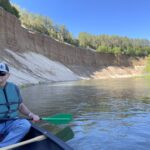
-
A balmy day followed by snow!
-
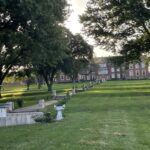
-
The former Odd Fellows Rest Home.
-
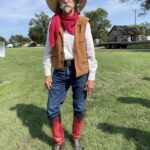
-
The cowboy on duty.
Interactions with friends and family. Reflecting on neighbor interactions, to book clubs, to yoga, to Firepit Friday gatherings, to coffee in the cabin and coffee shops, to the Veriditas and The Labyrinth Society colleagues. And, the bunny, Oreo, who was a wonderful Pandemic friend. She is still with us in memories and evidence of chewed cords and door frames. She was a character and a good friend.
Family connections over the miles on Facetime, ZOOM, in person, calls, photos, emails, and letters/cards. A way to be engaged with each other.
Engaging activities keep us active, healthy, and connected: Hoover Hatchery monthly blogs and Facebook Lives, writing for magazines and The Gazette, our Winding Pathways blogs, guiding labyrinth walks in person and virtually with Veriditas, walking and bicycling – on trails and (walking) inside as needed, playtime and projects with neighbor kids, monitoring students’ online course progress through Kirkwood Community College, watching Great Courses, helping with Faith Formation at church. And, appreciating the creative spirit and functionality of the Director of Faith Formation. The centering and balancing work with cancer patients and staff at the Nassif Community Cancer Center.
Reflecting on Deferred Gratification
Reflecting on the benefits of “deferred gratification” by having been careful with resources over the years and repairing/nurturing the land. Thanking the derecho trees for providing heat in the winter’s woodstove. Planting, tending and harvesting garden produce. Appreciating the chickens and giving them treats and a warm, safe place to live.
Thinking ahead: checking the air conditioner in April before the hot weather. Similarly, servicing the furnace and hot water heater in August. Maintaining the vehicles for optimal mileage and comfort – Rotate tires, change oil, fill windshield cleaner, change the blades, wash the outside, and detail the inside of the vehicles. Knowing steps to be prepared for outages, to stay home in inclement weather, and simply be at ease with what is.
Supporting educational to non-profit organizations locally and across the country.
Attitude
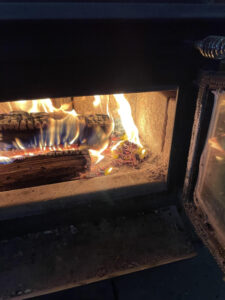
Releasing memories to the ethers.
Although we can be sour about the downs of 2022, and there were a number of them, we can also appreciate the positives. That slight shift in reflecting helps ease the path for ourselves and others as we journey into 2023. Now, with gratitude for reflecting on 2022, I respectfully add these gratitudes to the woodstove that keeps us warm. The memory of these reflections keeps my heart warm.
by Marion Patterson | Nov 10, 2022 | Birds, Nature
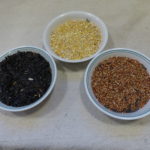
Sunflower seed, cracked corn, milo.
Feeding backyard birds is fun, but it’s become expensive. The price of black oil sunflower seed has doubled in just a couple of years.
To keep our birds well-fed and our budget under control we use Fourth Story Feeders. What are they? Well, the first story is the ground. The second is a picnic table or other platform a few feet off the ground, and the third is a metal shepherd’s hook shoved into the ground that gets feeders up four or five feet. We use all these and increasingly have taken the feed up the elevator to the fourth floor.
Raccoons, deer, opossums, and even bears love a nocturnal snack of expensive bird seed. Squirrels and wild turkeys gobble it up during the day. These animals easily access seeds on the first, second, and third floor – but not the fourth. Except for bears who can create complete havoc with feeders left out overnight.
Here’s how we created a feeding station that’s easy for birds to reach but inaccessible to deer, turkeys, raccoons, and opossums:
- Bought the tallest shepherd’s hook we could find.
- Pulled our homemade picnic table to a spot easy to see through our windows.
- Drilled two holes in the wooden table exactly the size of the “feet” of the shepherd’s hook. Used a hammer to lightly tap the “feet” into the holes.
- Suspended silo and suet feeders from the hooks that are now eight or nine feet above the ground and out of reach of deer and nearly impossible for raccoons and opossums to climb.
-
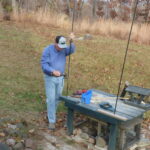
-
A few tools around the home help construct Fourth Floor Feeders
-
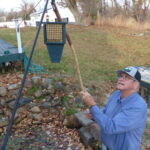
-
A pole with a hook makes lifting feeder high easy.
The birds love eating from the fourth story but there’s a problem. How to fill feeders so high up? Well, again, here’s how we solved the problem:
We scrounged a four-foot-long stick from a nearby lake that a beaver had cut and chewed off the bark. We bought an “S” hook from a hardware store and drilled a hole in the end of the stick. We pressed one side of the “S” hook into the wooden stick and had a handy tool.
With the hook on the stick, we can easily lift a feeder and hang it on the fourth story. A broomstick works as well as a beaver stick and the telescoping metal poles used to attach to paint rollers also can work. Most already have a hook built into the pole.
Squirrels can climb the steel shaft of the shepherd’s hook, but we foil them by coating its surface with a light spray of grease. Baffles are better at keeping these smart, pesky mammals at bay.
Materials Needed
Bird feeders
Picnic table
Shepherd’s Hook feeder holder
Pole for lifting feeder
“S” hookTube of spray grease
Helpful Tools
Drill and bit the same size as the shepherd’s hook’s diameter
Hammer
Although we still offer birdseed on the first, second, and third floors, now we present most of the seeds on the fourth floor. Saves seeds. Saves money. Frustrates deer, raccoons, turkeys, opossums, and squirrels.
-
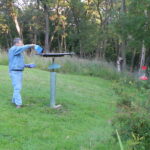
-
Hummingbird and platform feeders with baffle.
-
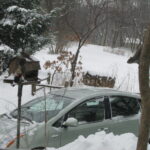
-
Squirrels quickly figure out how to access feeders
by Marion Patterson | Jul 21, 2022 | (Sub)Urban Homesteading, Nature
Nearly everyone remembers a brief, often scary time. Usually, it comes within months of high school graduation. It’s time to leave the familiarity of home and venture out on new endeavors. Change is often exciting but it requires venturing out into the unknown – often alone.
Rich remembers moving from New Jersey to a state he’d never been to, Idaho, to start college. Within days he was sworn into the Army as a student soldier. Lots of change.
Marion ventured forth in the same year but not quite so far. Her launching took her to Plymouth State University a ways north of her home.
Wildlife babies face many of the same huge life changes and uncertainties that we did, but they do it at a much younger age. When we walk along early summer trails, we often see baby cottontail bunnies. Some are no bigger than our hands, but they are on their own in a world full of bunny hazards. They must learn how to find food, water, and shelter while all sorts of predators try to make them food.
In June we watched several broods of house wrens fledge from boxes we put up near our kitchen window and in the garden. Earlier we’d seen mom and dad bring in sticks to make a nest. Then we didn’t see them often for a couple of weeks as they incubated their tiny reddish eggs.
-
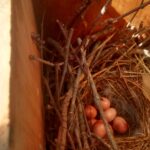
-
Wrens lay several small, reddish eggs.
-
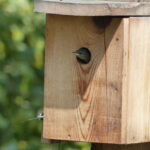
-
Wrens peek out of the box.
-
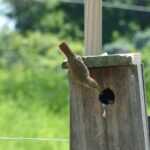
-
Wren adults are busy feeding the young.
On a miraculous day, those eggs become hungry but helpless babies. Mom and dad worked endlessly catching and delivering juicy caterpillars and adult insects to feed the youngsters a high-protein diet. They grow quickly, and a couple of weeks after hatching we see beaks poking out the birdhouse entrance.
It must be scary venturing forth, but mom and dad encourage them to fledge. Out they go. But life is not easy. They need to learn how to fly, where to find food, and how to be safe. Parents help for a while but soon they are on their own while mom and dad make a new nest and raise a second brood.
Launching…. fledging……is a tough transition time for people, bunnies, birds, and just about any other young animal.
by Marion Patterson | Jun 2, 2022 | Chickens, Garden/Yard, Geology/Weather, Hoover's Hatchery, Preparedness, Reflections/Profiles, Travel/Columns
Coming up to a year from the last post on the features we wrote for the Cedar Rapids Gazette, here is an updated list for the second half of 2021 and the first half (almost) of 2022. These features are in addition to our regular work with Hoover’s Hatchery blogs and FB Live and our own blogs for Winding Pathways.
May 8, 2022. Splish Splash! Whitewater Kayaking in Iowa. (No link to date)
April 22, 2022. Finding America On Roadways East.
April 13, 2022. Muscle Over motor When Boating.
March 21, 2022. Rockhounding.
January 30, 2022. Backpacking Bonus. (8B of GZ. No link to date) Available Green Gazette.
January 24, 2022. Distinctive Religious Structures.
January 16, 2022. Hiking Wild Areas. (no link to date) Available Green Gazette.
December, 2021. Country Schools. (no link to date) Available Green Gazette
November 15, 2021. Making a (Mini) Pitch for Soccer.
October 6, 2021. A visit with Midwest’s Pioneering Authors.
September 8, 2021. Taking a Slow Boat to Cassville.
September 6, 2021. Camping in Iowa’s Trout Country & Decorah’s Celebrities.
August 4, 2021. Parking While Headed East. And Solar Panels at Peoples.
by Marion Patterson | May 12, 2022 | Birds, Garden/Yard, Nature, Trees
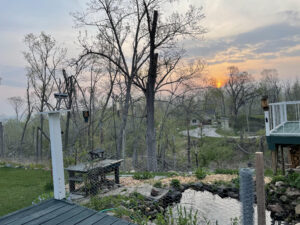 The distant view and the feel are “Hot August Days.” The near view and sounds are mid-May. With this hot weather, the trees have popped, the fruit trees are in full bloom, and the early garden plants emerging after the cooler and damp weather. We may break a century-old heat record today.
The distant view and the feel are “Hot August Days.” The near view and sounds are mid-May. With this hot weather, the trees have popped, the fruit trees are in full bloom, and the early garden plants emerging after the cooler and damp weather. We may break a century-old heat record today.
Two days ago we had the woodstove running. Now the air conditioner!
Notice the haze in the distance and the sun rising in the east – still six weeks from the Summer Solstice. Humidity levels are high. Winds are calmer after the front blew in.
The trees show emerging leaves and catkins. Insects work the fruit trees and low-growing spring flowers.
Birds are everywhere singing, courting, mating, and building nests. Amazing transformation in two days.
-
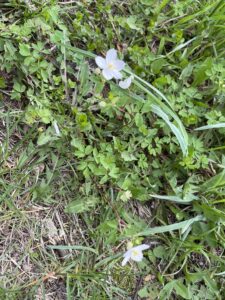
-
Deeply cut leaves of the false rue anemone.
-
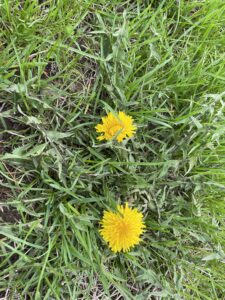
-
going at $8.00 per gallon at wineries, picking blooms from safe places is good income.
-
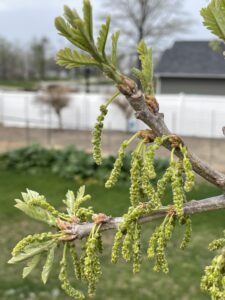
-
the oak popped out in one day with the heat.
-
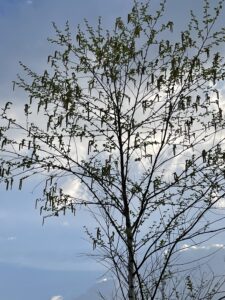
-
birds forage in emerging buds.













 The distant view and the feel are “Hot August Days.” The near view and sounds are mid-May. With this hot weather, the trees have popped, the fruit trees are in full bloom, and the early garden plants emerging after the cooler and damp weather. We may break a century-old heat record today.
The distant view and the feel are “Hot August Days.” The near view and sounds are mid-May. With this hot weather, the trees have popped, the fruit trees are in full bloom, and the early garden plants emerging after the cooler and damp weather. We may break a century-old heat record today.


